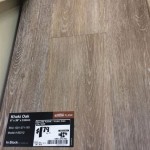When it comes to selecting the right floor underlayment for your vinyl flooring, there are several important considerations to take into account. Underlayment is a thin layer of material that is installed beneath your vinyl flooring and serves as a buffer between the subfloor and the flooring itself. It helps to protect your flooring from moisture, noise, and wear and tear, and it can also help to improve the overall look and feel of the floor.
Types of Floor Underlayment
Floor underlayment can be made of a variety of materials, including foam, rubber, and felt. Foam underlayment is a popular choice for vinyl flooring, as it is easy to install and provides excellent cushioning for the floor. It is also highly resistant to moisture and temperature, making it a great option for areas that are prone to extreme temperatures. Rubber underlayment is also a good choice, as it offers superior soundproofing capabilities and is resistant to water damage. Felt underlayment is a bit less durable, but it is a great choice for areas that are not prone to moisture or temperature extremes.
Factors to Consider
When choosing the right floor underlayment for your vinyl flooring, there are several factors that you should consider. The type of subfloor you have will be a major factor in determining the type of underlayment that you need. If you have a concrete subfloor, then foam or rubber underlayment is typically the best option. If you have a wood subfloor, then felt underlayment is usually the best choice. Additionally, you will need to consider the type of vinyl flooring that you have, as some types of vinyl require a thicker underlayment than others.
Installation Tips
Once you have chosen the right underlayment for your vinyl flooring, it is important to install it correctly. The first step is to clean the subfloor thoroughly and make sure that it is free of any dirt or debris. Next, you will need to roll out the underlayment in strips and use a utility knife to cut it to size. Make sure that the seams are properly sealed and that there are no gaps or air pockets. Finally, use a flooring adhesive to secure the underlayment in place.
Benefits of Underlayment
Underlayment can provide numerous benefits for your vinyl flooring. It can help to reduce sound levels and provide cushioning for the floor. Additionally, it can help to protect your floor from moisture, temperature extremes, and wear and tear. Underlayment can also help to enhance the overall look and feel of your floor.
Conclusion
Choosing the right floor underlayment for your vinyl flooring is essential for ensuring that your floor is both comfortable and durable. By considering the type of subfloor you have, the type of vinyl flooring you have, and the benefits of underlayment, you can make an informed decision and find the perfect underlayment for your needs.
.jpg?resizeid=11&resizeh=596&resizew=865)





![]()







Related Posts









